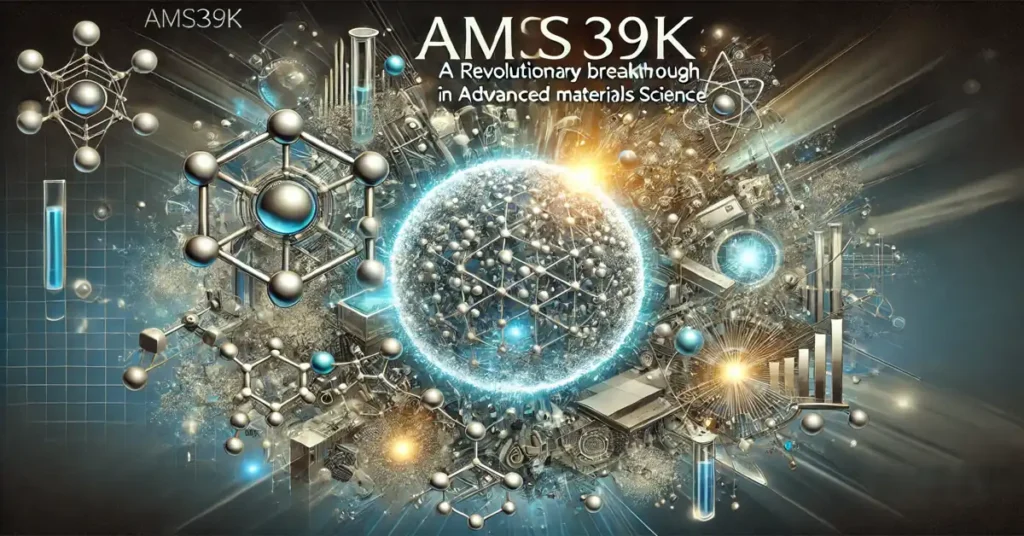In the ever-evolving world of material science, new innovations continuously reshape industries, offering advancements that promise to enhance functionality, performance, and sustainability. Among these breakthroughs, AMS39K stands out as a revolutionary development in the realm of advanced materials. With its unique properties and diverse range of applications, AMS39K has the potential to significantly impact multiple industries. This article delves into the intricacies of AMS-39K, exploring its composition, properties, applications, and the transformative impact it could have across various sectors.
AMS39K is a cutting-edge material that has been garnering significant attention for its unique properties and potential applications. It is a high-performance composite material designed to address the growing demand for materials capable of withstanding extreme conditions while maintaining superior durability and flexibility. Developed through advanced research and rigorous testing, AMS39K is engineered to meet the stringent demands of modern industries, from aerospace and automotive to electronics and renewable energy. In this comprehensive article, we will examine the composition, characteristics, applications, and challenges of AMS-39K and consider the promising future of this advanced material.
The Composition and Structure of AMS39K
What is AMS39K?
AMS39K is a hybrid composite material, combining elements from both metallic and polymer matrices. This hybrid approach allows it to leverage the strengths of each component, resulting in a material that exhibits exceptional mechanical and thermal properties. At its core, AMS39K is designed to offer an optimal balance of strength, flexibility, and resilience, making it suitable for applications that require materials capable of performing under extreme conditions.
The composition of AMS-39K includes a carefully engineered blend of metals and polymers, which work together to deliver unique benefits. The metallic components provide the strength and rigidity necessary for structural stability, while the polymer matrix contributes to flexibility, lightweight properties, and resistance to environmental factors such as corrosion and temperature fluctuations. This combination results in a material that is not only highly durable but also versatile enough to be used in a variety of applications.
Key Properties of AMS39K
The unique composition of AMS-39K gives it several key properties that make it a standout material in the field of material science. Some of these properties include:
- High Strength-to-Weight Ratio: AMS-39K is known for its exceptional strength-to-weight ratio, making it ideal for applications where reducing weight is crucial without compromising structural integrity. This property is particularly valuable in industries such as aerospace and automotive, where weight reduction can lead to increased efficiency and reduced fuel consumption.
- Superior Thermal Stability: AMS39K exhibits excellent thermal stability, allowing it to withstand high temperatures without degrading. This property makes it suitable for use in high-temperature environments, such as engine components or electronic devices that generate significant heat during operation.
- Corrosion Resistance: The polymer components of AMS-39K provide it with resistance to corrosion, making it ideal for use in environments where exposure to moisture, chemicals, or other corrosive elements is a concern. This property enhances the longevity of AMS-39K and reduces the need for frequent maintenance or replacement.
- Flexibility and Impact Resistance: Unlike many traditional metals, AMS-39K offers a degree of flexibility that allows it to absorb impacts without breaking or deforming. This makes it an attractive choice for applications where impact resistance and material toughness are essential.
- Electrical Conductivity: AMS-39K can be engineered to exhibit varying levels of electrical conductivity, depending on the application. This property is useful in the electronics industry, where materials with specific conductive properties are required for components such as sensors, circuits, and connectors.
Applications of AMS39K Across Various Industries
The versatility of AMS39K opens up a multitude of potential applications across various industries. Its unique properties make it suitable for a wide range of uses, from aerospace engineering to energy storage. Below, we explore some of the key applications of AMS-39K:
1. Aerospace Industry
The aerospace industry is constantly seeking materials that offer high performance, reduced weight, and superior durability. AMS39K fits these requirements perfectly, thanks to its high strength-to-weight ratio and excellent thermal stability. In the aerospace sector, AMS-39K can be used for components such as structural frames, engine parts, and heat shields. Its lightweight properties contribute to improved fuel efficiency, while its ability to withstand extreme temperatures makes it suitable for use in high-temperature environments encountered during flight.
2. Automotive Industry
The automotive industry is another sector where AMS-39K has significant potential. As automakers strive to reduce vehicle weight to improve fuel efficiency and meet environmental regulations, materials like AMS39K offer an attractive solution. AMS-39K can be used in automotive components such as chassis, body panels, and suspension systems, where its combination of strength, flexibility, and corrosion resistance is highly beneficial. Additionally, its impact resistance makes it an ideal choice for parts that need to withstand collisions and other forms of mechanical stress.
3. Electronics and Electrical Engineering
AMS39K’s unique combination of flexibility, thermal stability, and electrical conductivity makes it an excellent material for use in the electronics and electrical engineering industries. It can be used in the production of electronic components such as circuit boards, connectors, and sensors, where its ability to conduct electricity and withstand heat is crucial. AMS-39K’s flexibility also makes it suitable for use in flexible electronics, which are becoming increasingly popular in consumer devices such as wearables and foldable displays.
4. Renewable Energy Sector
In the renewable energy sector, materials that can withstand harsh environmental conditions and maintain their performance over long periods are essential. AMS-39K’s corrosion resistance, thermal stability, and mechanical strength make it a suitable material for use in renewable energy applications, such as wind turbine components, solar panel frames, and energy storage systems. Its durability ensures that renewable energy infrastructure can operate efficiently and reliably, even in challenging conditions.
5. Construction and Infrastructure
AMS39K can also be used in the construction and infrastructure sectors, where its high strength, corrosion resistance, and lightweight properties make it an attractive choice for structural components. It can be used in the construction of bridges, buildings, and other infrastructure projects that require materials capable of withstanding heavy loads and harsh environmental conditions. The use of AMS-39K in construction can lead to longer-lasting structures with reduced maintenance requirements.
6. Military and Defense Applications
The military and defense sectors often require materials that can withstand extreme conditions while offering superior performance. AMS-39K’s combination of high strength, impact resistance, and thermal stability makes it suitable for use in military applications, such as armor plating, vehicle components, and protective gear. Its ability to absorb impacts without breaking makes it an ideal material for use in protective equipment designed to shield personnel from ballistic threats.
Ongoing Research and Development of AMS39K
As AMS39K continues to undergo research and development, its potential applications are likely to expand even further. Ongoing studies aim to optimize its properties and explore new ways to integrate it into emerging technologies. Key areas of focus for future research and development include:
1. Enhancing Mechanical Properties
Researchers are working to further enhance the mechanical properties of AMS-39K, such as its tensile strength, flexibility, and impact resistance. By optimizing the composition and structure of the material, scientists aim to create even more robust and versatile versions of AMS-39K that can be used in a wider range of applications.
2. Exploring Nano-Scale Modifications
One of the most promising areas of research involves incorporating nano-scale modifications into AMS39K to improve its properties. By introducing nanoparticles or nanofibers into the material, researchers hope to enhance its electrical conductivity, thermal stability, and overall performance. These nano-scale modifications could open up new possibilities for AMS39K in advanced electronics, energy storage, and other high-tech applications.
3. Developing Sustainable Production Methods
As sustainability becomes an increasingly important consideration in material science, researchers are exploring ways to develop more environmentally friendly production methods for AMS39K. This includes reducing the energy consumption and carbon footprint associated with manufacturing the material, as well as exploring the use of recycled or renewable raw materials. By making the production of AMS39K more sustainable, researchers hope to increase its appeal to industries seeking greener solutions.
4. Integrating AMS39K into Emerging Technologies
The versatility of AMS39K makes it a promising candidate for use in emerging technologies, such as electric vehicles, renewable energy storage systems, and advanced robotics. Researchers are working to integrate AMS39K into these technologies, exploring how its unique properties can enhance performance, durability, and efficiency. For example, AMS39K’s lightweight properties could make it an ideal material for use in electric vehicle components, helping to reduce the overall weight of the vehicle and extend its range.
Challenges and Considerations of AMS39K
Despite its promising attributes, AMS39K is not without challenges. Some of the key considerations that need to be addressed include:
1. Production Costs
One of the main challenges associated with AMS39K is its production cost. The hybrid composition of the material, which includes both metallic and polymer components, can make it more expensive to produce compared to traditional materials. Reducing the production cost of AMS39K will be crucial for its widespread adoption across various industries. Researchers are exploring ways to streamline the manufacturing process and reduce costs, making AMS39K a more economically viable option for large-scale applications.
2. Material Compatibility
Another consideration when using AMS39K is its compatibility with other materials. In many applications, AMS39K will need to be used in conjunction with other materials, and ensuring that it is compatible with those materials is essential for maintaining the integrity and performance of the final product. Researchers are working to better understand how AMS39K interacts with other materials and to develop guidelines for its use in composite structures.
3. Scalability of Production
Scalability is another challenge that needs to be addressed for AMS39K to achieve widespread adoption. While the material has shown promise in laboratory settings, scaling up production to meet the demands of industries such as aerospace and automotive can be challenging. Developing efficient and scalable production methods will be key to ensuring that AMS39K can be produced in the quantities needed for large-scale applications.
4. Long-Term Performance
While AMS39K has demonstrated impressive properties in initial testing, understanding its long-term performance is essential for its adoption in critical applications. Researchers are conducting long-term studies to assess how AMS39K performs under extended use and exposure to harsh conditions. These studies will help determine the material’s durability and reliability, providing valuable information for industries that require materials capable of withstanding prolonged stress and environmental exposure.
Conclusion: The Future of AMS39K in Advanced Material Science
AMS39K represents a significant advancement in the field of material science, offering a unique combination of strength, flexibility, thermal stability, and corrosion resistance. Its hybrid composition, which combines elements from both metallic and polymer matrices, allows it to leverage the strengths of each component, making it suitable for a wide range of applications across various industries. From aerospace and automotive engineering to electronics, renewable energy, and construction, AMS39K has the potential to revolutionize how materials are used in modern technology.
As ongoing research continues to optimize the properties of AMS39K and explore new applications, the future looks promising for this advanced material. By addressing challenges such as production costs, material compatibility, and scalability, researchers are working to ensure that AMS39K can achieve widespread adoption and make a meaningful impact across multiple sectors.
Whether it’s improving the efficiency of electric vehicles, enhancing the performance of renewable energy systems, or creating more durable aerospace components, AMS39K is poised to play a key role in shaping the future of material science. Its versatility, combined with its impressive mechanical properties, makes it a valuable addition to the growing list of advanced materials that are driving innovation and progress in the 21st century.
The development of AMS39K is a testament to the power of innovation and the importance of pushing the boundaries of what materials can achieve. As industries continue to evolve and face new challenges, advanced materials like AMS39K will be at the forefront, providing the solutions needed to meet the demands of a rapidly changing world.







